The snow skin mooncake is made with a sweet mochi dough and a creamy custard filling, stamped with a beautiful pattern that celebrates the Mid-Autumn Festival. I shared many step-by-step photos and a video to show you how to make them in your own kitchen. It’s the perfect recipe to celebrate the Mid-Autumn Festival. {Vegetarian}

Mid-Autumn Festival is just around the corner and it’s that time of the year that families start to buy or make their favorite mooncakes. In the past, the baked traditional mooncake was the staple to celebrate the festival. But these days, there are many different types of modern mooncakes that people love to enjoy. For example, these round pastry mooncakes filled with red bean paste and salty duck egg yolks.
Today, I want to share this snow skin mooncake with a custard filling recipe. Snow skin mooncake is a new type of mooncake that’s gradually gaining popularity in recent years.
What is a snow skin mooncake?
“Snow Skin” is translated from the Chinese “Bing Pi” (literally meaning “Icy Skin”). The word snow is used because of the color and texture of the mooncake wrapper. Different from the traditional baked sugary pastry, the snow skin mooncake is made with a mochi-like dough and usually served chilled. Sometimes people also call it a mochi mooncake.
Just like regular mooncakes, snow skin mooncakes can be filled with red bean paste, black sesame paste, lotus seed paste, and other sweet fruity fillings.
In this recipe I will be using a custard filling. Buttery, milky and creamy, it’s one of my favorite fillings to enjoy snow skin mooncake.
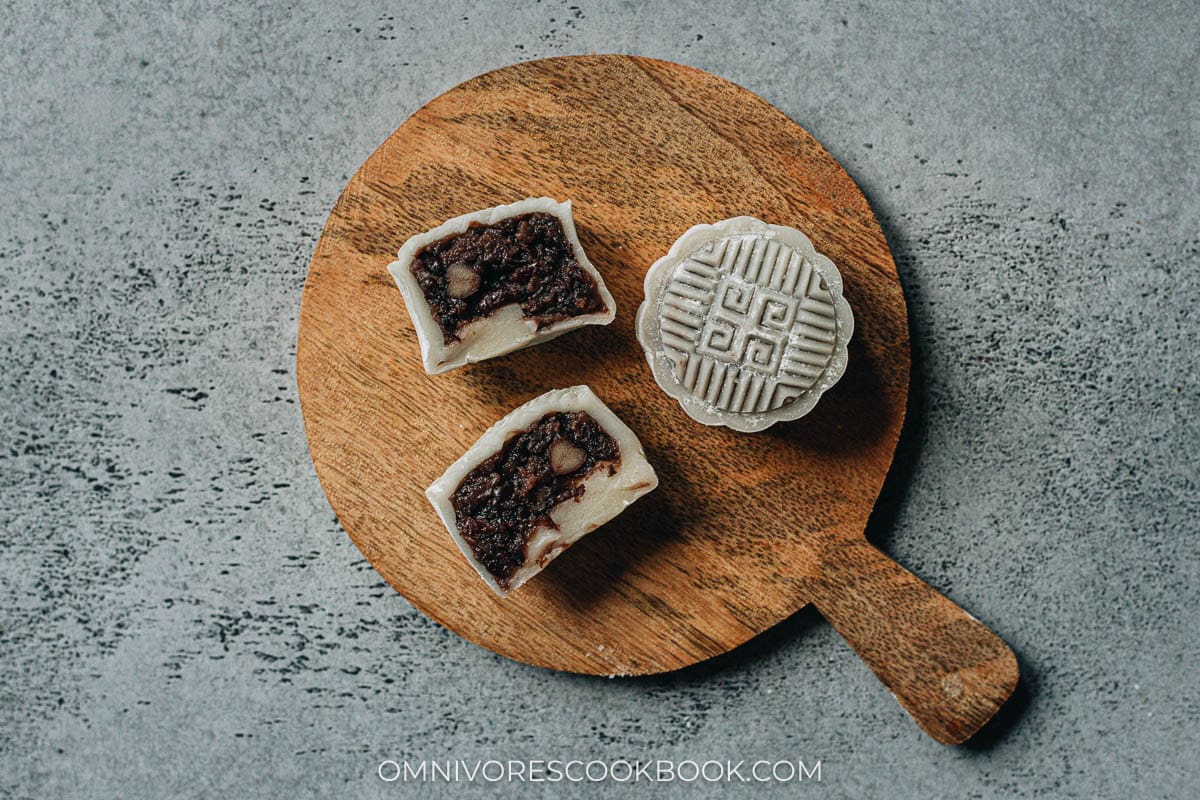
How to make snow skin mooncake
1. Prepare the custard filling
This recipe uses a standard custard recipe as the base. It contains more flour than regular custard so it is easy to form the mooncakes.
It uses 7 ingredients that are shown in the picture below.
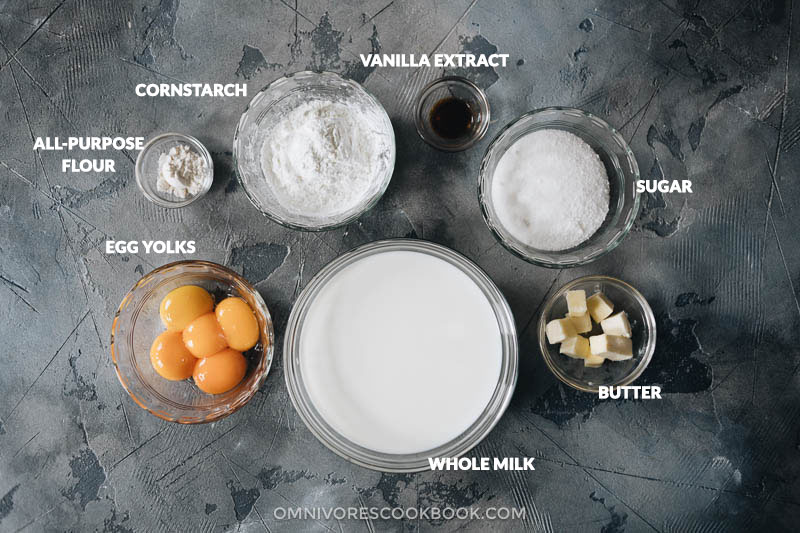
The workflow is:
- Mix the dry ingredients
- Heat up the milk and half of the sugar until warm
- Mix the egg yolks with the dry ingredients
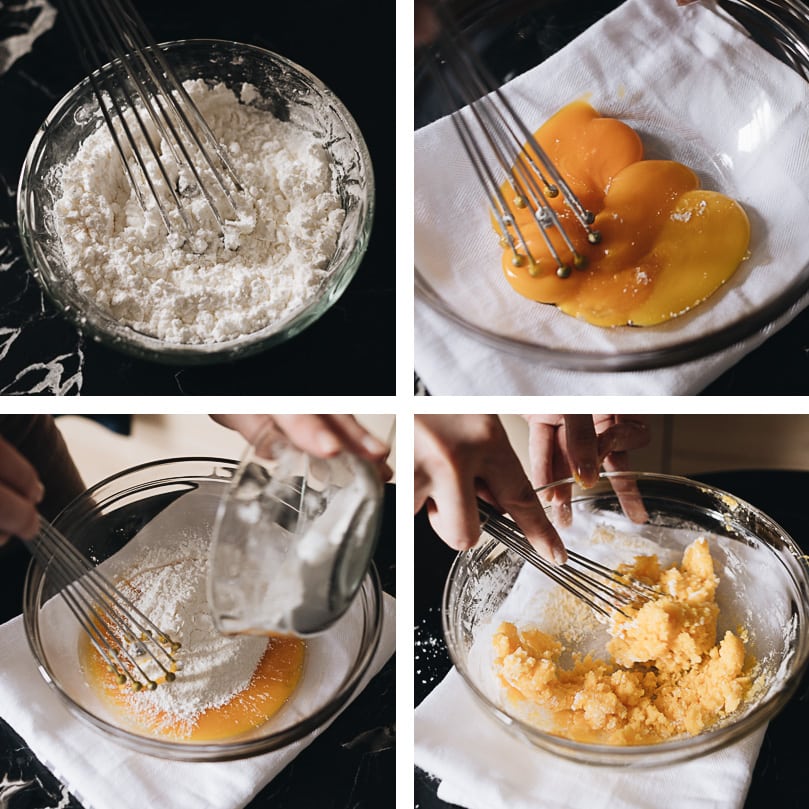
- Add the milk into the egg yolk and flour mixture
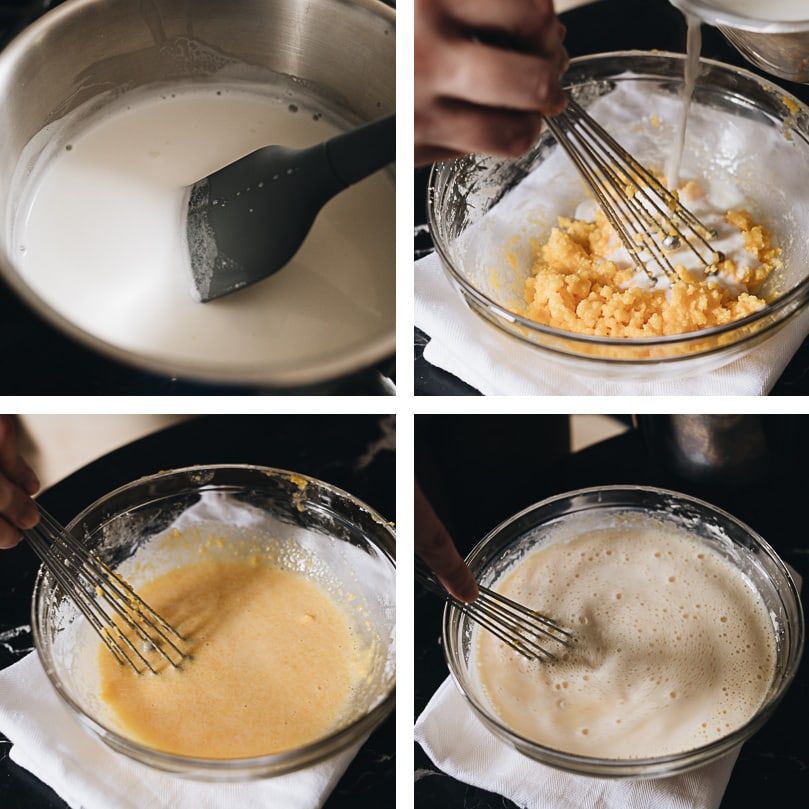
- Cook the mixture until it thickens
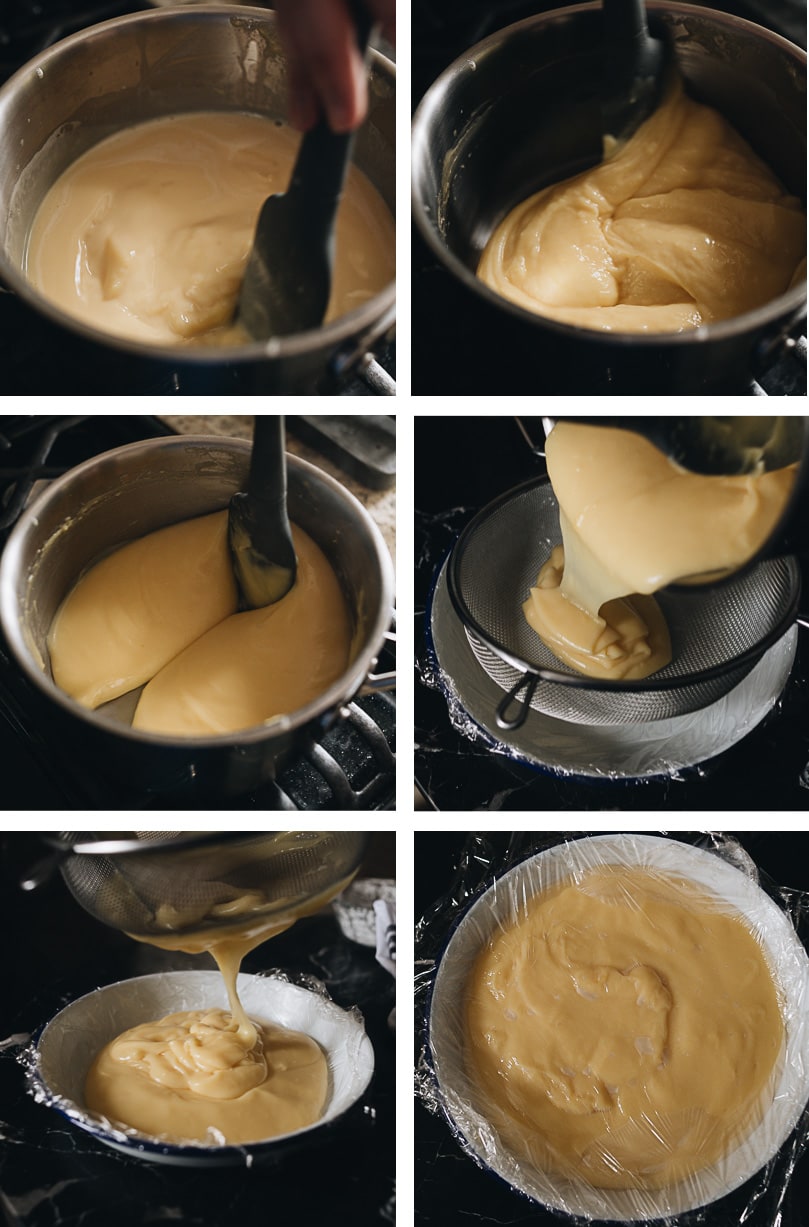
- Chill the custard in the fridge
Note:
- Make sure you don’t overheat the milk, otherwise it will cook the eggs and make the filling into a lumpy soup. I usually use a thermometer to make sure the milk doesn’t heat over 150 F (65 C). If you do not have a thermometer, you should heat up the milk over low heat until it’s warmed up but not too hot if you put your finger into the milk.
- Do not mix the egg yolks with the dry ingredients before you heat up the milk. The sugar will cook the egg yolk and change its texture if added too early.
- Stir the custard constantly when you heat it up on the stove. The mixture will be very runny at the beginning and will take a few minutes to cook. But once it starts to thicken, it happens very fast, like flipping a switch.
- Once the custard starts to bubble, make sure to stir constantly and let it cook boiled for 1 full minute. This will make sure the flour is cooked thoroughly, so the custard will be able to thicken up once chilled.
- Chill the custard completely before forming the mooncake. The texture will harden and become possible to shape once cooled.
2. Prepare the dough
The dough uses 7 ingredients that are shown in the picture below.
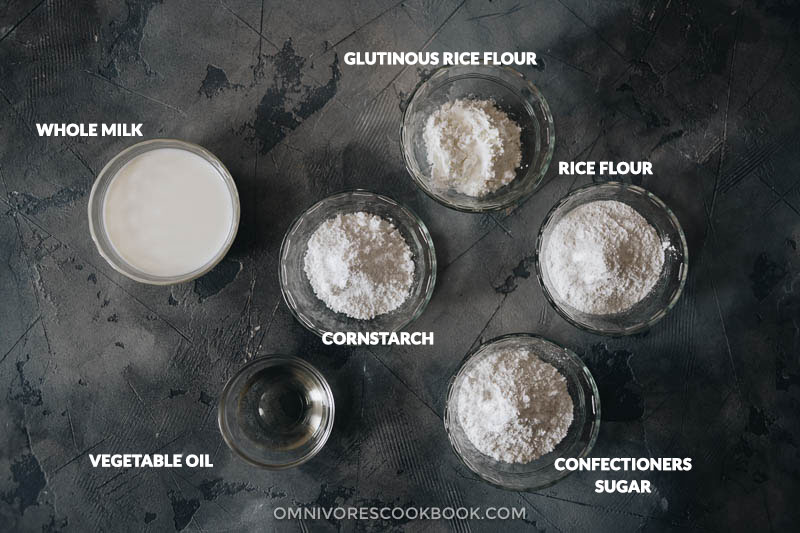
The workflow is:
- Combine the dry ingredients
- Combine the wet ingredients
- Mix the dry and wet ingredients into a very runny batter
- Steam the batter until cooked through

- Knead the cooked batter into a dough ball
- Chill the dough ball in the fridge
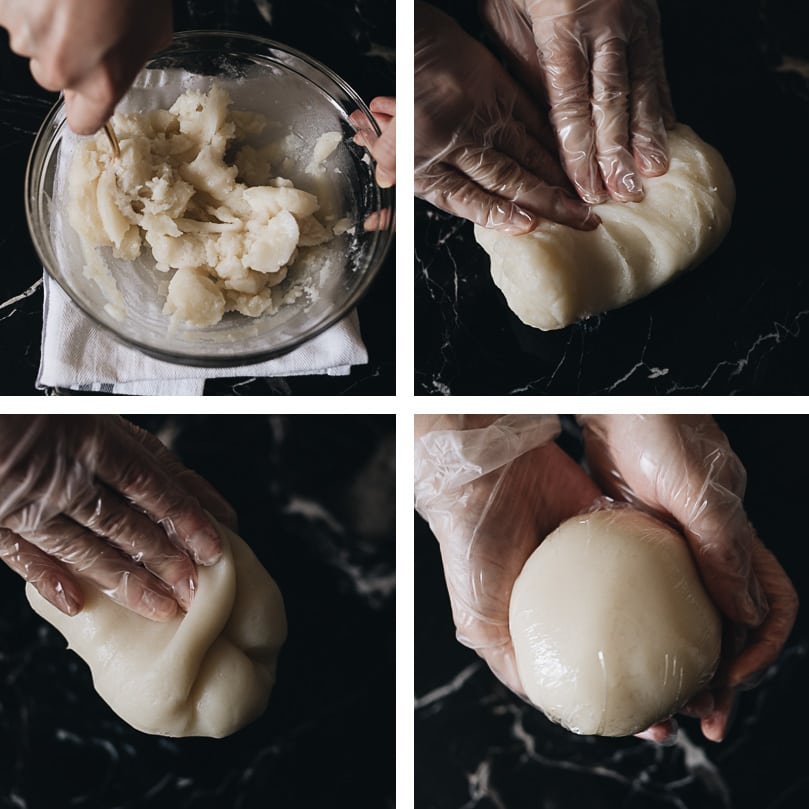
Note:
- You can add different extracts into the dough. Almond, rose, and pandan extracts all work in this recipe.
- You can add food coloring into the dough. Many recipes use a few drops of red or green food coloring to make pink and pale green mooncakes.
- Knead the dough once it’s steamed. The texture of the dough will soften a lot and become more palatable once kneaded.
- Chill the dough in the fridge for at least 30 minutes, so it hardens up a bit for the molding.
- It’s possible to make the dough ahead of time and chill it overnight. But we’ve found that the freshly made dough is easier to mold and tastes slightly better.
3. Make dough and filling balls
Once you’ve chilled the custard, mix it well with a spatula. This will help the custard to even out and make it easier to shape.
You might find the custard is quite soft and stick to your hands when shaping them. I highly recommend wearing a pair of disposable gloves, and slightly grease it with oil. It will make the custard much easier to shape.
Shape the custard and the dough into balls. And once you shape the custard into balls, immediately cover with plastic wrap and store in the fridge so it stays cool and firm.
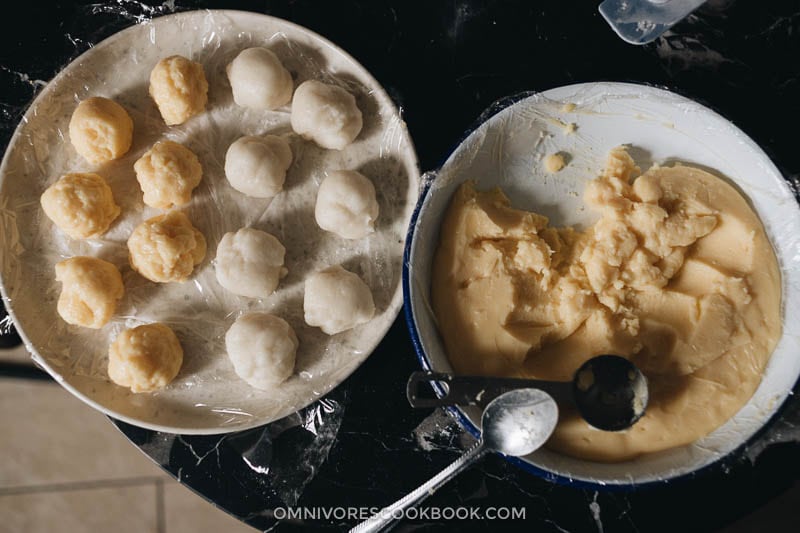
The easiest and most consistent way is to use a scale to measure out the portions. But if you don’t have a scale, you can use a tablespoon to measure one round tablespoon of dough and one round tablespoon of filling.
In this recipe, I used 25 grams of filling and 25 grams of dough. For the dough, I measured out a bit more dough to make a larger wrapper, so it’s easier to assemble the mooncakes. Once you wrap the mooncake, it will form more dough on top where you seal the filling. You can pinch off the extra dough so the mooncake skin will be even and thin throughout. It eventually makes a 45-gram mooncake (25 grams of filling + 20 grams of dough).
4. Assemble the mooncakes
To assemble the snow skin mooncakes, you need to:
- Roll a dough ball into a thin wrapper.
- Wrap the filling like you would wrap a dumpling (sort of).
- Pinch off the extra dough formed on top of the filling.
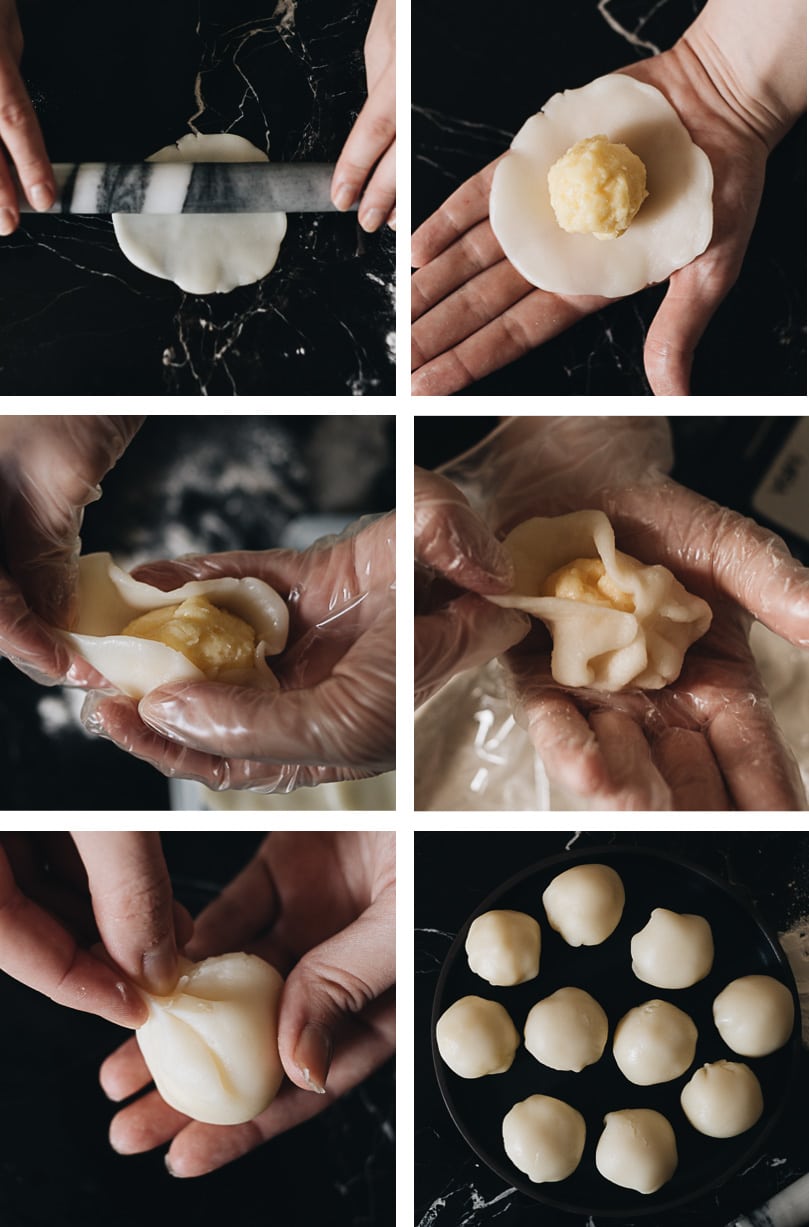
Note:
- You can use your hands to form the wrapper as well. Although I found that a rolling pin yields a thinner and more even wrapper.
- Do NOT dust your working surface with extra flour. The dough contains enough oil so it won’t stick to your working surface easily. Adding extra flour will change the texture of the dough.
- You can wear a pair of disposable gloves when you work on the mooncakes. Personally I like to shape the dough using my hands.
5. Mold the mooncake
To speak the truth, the “mochi” you’ve made at this point is kinda ready to eat and tastes delicious. But of course, you’ll need to mold them into beautiful patterns to call them mooncakes.
To make this happen, you need a mooncake mold. The traditional ones are made of carved wood. But I found that plastic molds are easier to source and quite easy to use. You can find them in Asian markets or on Amazon.
To mold the mooncake, you need to:
- Dust the assembled ball with a thin layer of cornstarch.
- Fit the ball into the mooncake mold and press for 30 seconds.
- Release the mooncake and pray that it comes out perfectly without falling apart.
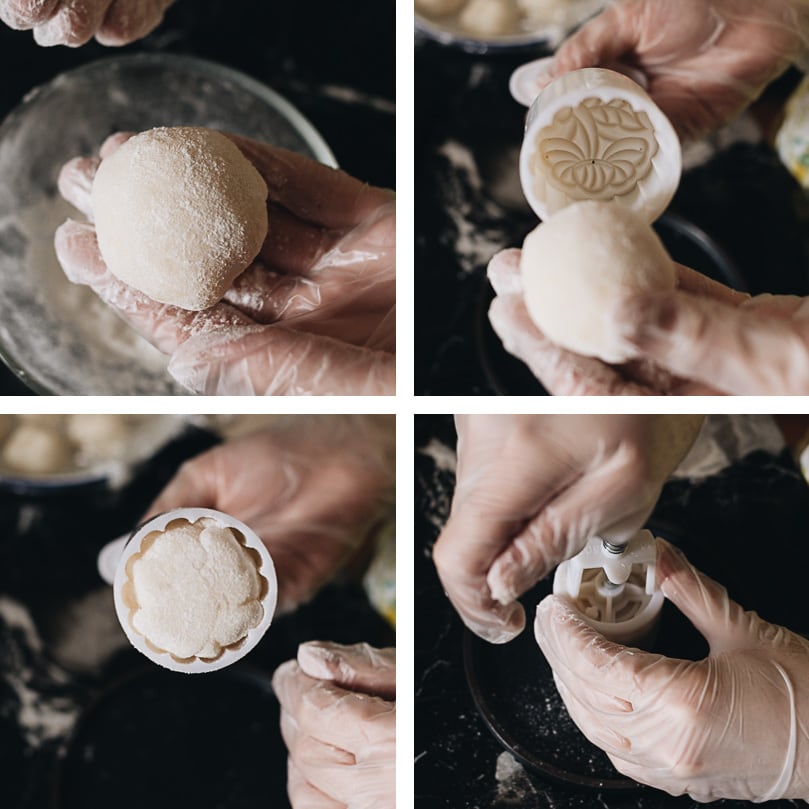
Note:
- Ideally, you should be using Gao Fen (cooked glutinous flour) to dust the mooncake. But since it’s hard to find, most recipes ask you to cook the glutinous flour in a pan for the coating. I found that step unnecessary because cooking the flour doesn’t eliminate its powdery raw taste. I used cornstarch to coat the mooncake, which is the approach usually used in mochi recipes.
- The pattern on the mooncake will fade a bit over time, which is unavoidable for any type of snow skin mooncake. Store-bought mooncakes use additives and are sometimes frozen to keep the mooncake in a perfect pattern. That’s why homemade ones might look less perfect, but they actually have a much better taste than the store-bought ones.


Frequently asked questions
- Why does my custard turn out too soft and I can’t shape it after chilling?
Make sure you bring the custard mixture to a boil (it should be bubbling if you stop stirring it for a moment), and let it boil while mixing it for a full minute. This is the key to make sure the custard is properly cooked and will firm up once chilled.
- Why does the mooncake skin harden once I stored it overnight in the fridge?
The mooncake skin will harden when it’s cooled. The best way is to let the mooncake rest at room temperature so the skin will turn a bit softer before eating.
If you do not plan to serve the mooncake the same day, I would keep them refrigerated in the wrapped ball form without molding them. You can mold them the next day before serving. So the patterns will stay more clear, and the mooncake skin will soften a bit too.
- The custard and the dough are too sticky and hard to work with. Should can I do?
The best way is to wear disposable gloves while working on the cooked dough and the filling. It keeps them from sticking and makes the workflow much smoother.
I hope you enjoy the recipe! Make sure you check out the video if you’re not familiar with the process. It is indeed a challenging project but the result is so rewarding!

More recipes for Mid-Autumn Festival
- Traditional Mooncake with Black Sesame Filling
- Dan Huang Su (Pastry Mooncake with Salty Egg Yolk, 蛋黄酥)
- Homemade Lotus Seed Paste (莲蓉馅)
- Mid-Autumn Festival Menu
- How to Make Red Bean Paste
- How to Make Shumai (烧麦, Steamed Dumplings)
- How to Make Chinese Dumplings from Scratch
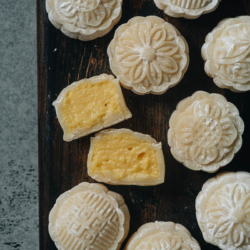
Snow Skin Mooncake with Custard Filling (冰皮月饼)
Ingredients
Custard
- 40 grams (6 tablespoons) cornstarch
- 5 grams (2 teaspoons) all-purpose flour
- 112 grams (1/2 cup) granulated sugar
- 5 large egg yolks
- 480 grams (2 cups) whole milk
- 30 grams (2 tablespoons) butter
- 1/2 teaspoon vanilla extract
Wrapper
- 120 grams (1 cup) glutinous rice flour
- 120 grams (1 cup) rice flour
- 120 grams (1 cup) cornstarch , and extra for coating the mooncakes
- 100 grams (3/4 cup) confectioners sugar
- 350 grams (1 1/2 cup) whole milk
- 55 grams (1/3 cup) vegetable oil
- 1/2 teaspoon vanilla extract
Equipment
Instructions
Make the custard
- Mix the cornstarch, all-purpose flour, and half of the sugar together in a small bowl.
- Place the egg yolks in a large bowl. Stir a few times to mix the yolks.
- Add the milk and the remaining half of the sugar into a small saucepan. Heat over medium heat. Stir occasionally to dissolve the sugar completely. Cook until it reaches about 120°F/ 49°C (no more than 150°F / 65°C). You might see a few bubbles here and there. If the milk starts foaming, it’s too hot.
- While the milk starts to get warm, add the dry ingredients (from step 1) into the bowl with the egg yolks. Whisk until it forms an even paste. Do not add the dry ingredients too early, because the sugar will change the texture of the eggs.
- Add the warm milk into the egg yolk mixture, about 1/4 cup at a time. Whisk constantly until the milk is fully incorporated into the paste. Continue to add more milk a 1/4 cup at a time and keep stirring, until it forms a thin, smooth mixture and all the milk is added.
- Return the mixture back into the pot (the one you used to heat the milk). Heat over medium heat and stir constantly while scraping the bottom (to prevent from burning), until the mixture thickens. Keep cooking and stirring, until it starts to bubble. Stop your spatula for a moment to make sure that the custard is boiling. Keep stirring and boiling for one full minute. This is important so the custard will be able to thicken after chilling.
- Remove the pot from the stove. Add the butter and vanilla extract. Stir to mix well.
- Line a large deep plate with plastic wrap. Place a large mesh strainer on top.
- Pour the custard into the lined plate over the strainer to smooth out the texture. Use a spatula to press the strainer if any lumps remain.
- Cover the custard with plastic wrap. Press the wrap against the custard, so it won’t form a skin once it’s chilled.
- Chill the custard in the fridge until it’s cooled completely, 2 hours or so. Or in the freezer for 30 mins.
Prepare the mooncake dough
- Prepare a large bowl that can fit into your steamer. Place a large strainer on top.
- In another medium-sized bowl, add the glutinous rice flour, rice flour, and cornstarch. Mix well with a fork.
- Line a large mesh strainer over the bowl and sift the confectioner’s sugar through it. Use your fingers or a spoon to press the sugar through if any lumps exist.
- Add the milk, oil, and vanilla extract into a small bowl. Stir to mix well.
- Use your fork to form a hole in the middle of the flour. Add 2 to 3 tablespoons of the milk mixture at a time. Stir until the liquid is incorporated into the flour completely. Repeat the process until it forms a very runny batter.
- Pour the mixture into the large bowl (you prepared in step 1) over the strainer. Press the lumps using a spoon. Once strained, the mixture will thicken a little bit.
- Prepare a steamer by pouring 1 inch (2.5 cm) of water into the steamer pot. Cover and heat over medium-high heat until boiling. Place the bowl with the batter into the steamer rack. Place the rack over the boiling pot. Cover and steam until the batter is cooked completely, 25 to 30 minutes. After 25 minutes, examine the dough by inserting a spoon into the middle. The spoon should come out clean, and the dough should feel very stiff.
- Once done, remove the lid, and transfer the steaming rack with the bowl onto your kitchen counter to cool off for a few minutes.
- Fold a kitchen towel a few times and place it on your working surface. Remove the bowl with the dough wearing oven mitts, and transfer the bowl onto the towel.
- Scrape the dough from the bowl and knead it using a spoon, until it forms a dough ball, 5 minutes or so.
- Transfer the dough onto a clean surface. Note, do not add any flour onto the surface or dust your hands with it. Knead the dough using your hands until it’s smooth, 5 minutes or so. The dough will soften once done.
- Form the dough into balls – Measure 25 grams of dough (about 1 round tablespoon) and use your hands to roll it into a ball. Place the dough balls into a container and cover. Chill in the fridge until the custard is ready to use.
Ingredient storage
- You can keep the dough and the custard filling refrigerated for a couple of hours, up to overnight, until ready to assemble. The dough will become a bit stiff if you chill it overnight. If you want the freshest taste, you should assemble the mooncakes the same day you make the dough and filling.
Assemble the mooncakes
- Once the custard is fully chilled, use a spatula to mix the custard again to even out the texture. This step will soften the custard a bit, but make it easier to scoop and shape.
- Form the custard into balls – Measure 25 grams of filling (about 1 round tablespoon) and use your hands to press and roll, until it forms a ball. I highly recommend wearing disposable gloves to help with this process, so the custard doesn’t stick to your hands.
- Transfer the filling balls into a plate and wrap it. Chill for another 30 minutes.
- Place the dough ball on a clean working surface. Use a rolling pin to roll it into an even, thin, round disc that is about 4” (9 to 10 cm) in diameter. Carefully remove it from the surface onto your palm.
- Place a custard ball in the center of the wrapper. Use your other hand to gather the wrapper onto the top of the custard filling. The dough sheet will start to form pleats and create a thicker layer. Try to pinch the extra dough together using your fingers, and pinch off the dough. The process will keep the mooncake skin even and thin, to create a better mouthfeel. Once done, place the mooncake onto a plate, pleated-side-down. Loosely cover it with plastic wrap to prevent them from drying out. Repeat the process to wrap the rest of the mooncakes.
To mold the mooncakes
- Install the pattern plate into the mooncake mold, with the pattern side facing downward. If you’re using the round shape, you can twist the lever of the mold so the pattern plate will snap onto the lever. It’s not required but it makes the process a bit easier.
- Dust the mooncake with a very thin layer of cornstarch. (*Footnote 1)
- Carefully place the wrapped mooncake balls into the mold, smooth surface against the pattern plate.
- Place the mold onto a clean, flat surface. Gently press the lever until the dough is against your table surface. Hold it for at least 30 seconds. It will help the pattern to form. Once done, push the lever to release the mooncake. Repeat the process to mold all the mooncakes.
- The mooncakes are ready to eat!
Storage
- Transfer the mooncakes into an airtight container. Store them in the fridge for 3 to 4 days. To enjoy the mooncakes with a better texture, transfer them to your kitchen counter and wait for them to return to room temperature. You can eat the chilled mooncakes, but the skin will be a bit stiff.
- Note, do not freeze the mooncakes. This will change the texture of the custard and make it very grainy.
Notes
- Most mooncake recipes call for Gao Fen (or cooked glutinous rice flour) for this step. If you have Gao Fen on hand, you can use it for dusting. If not, simply use cornstarch and the result will be good as well.
Video
Nutrition
The recipe was published in 2019 and updated in 2023 with a new video. I also slightly changed the dough recipe so it is easier to shape. The custard steps are clarified to solve the issue that it’s hard to shape after chilling.
Lilja Walter was a part of the Omnivore’s Cookbook team and worked closely with Maggie to develop and test this recipe.














Hi Maggie, thank you for this great recipe. I want to try making it and I have access to 糕粉, but I think I missed the part that explains how to make dough with it. Could you please point me in the right direction?
Hi Anya, unfortunately I don’t have the dough recipe with Gao Fen. We started out testing it, but before perfecting the recipe we decided to change direction because the ingredient is kinda hard to find. I recommend you to follow this video if you want to make the mooncake dough with Gao Fen: http://YouTube.com/watch?v=AtbQ7254Cpg
It’s pretty simple, you basically make the dough by mixing Gao Fen, confectioners sugar, cold water and shortening. No need to cook it and can use it to wrap the mooncake directly.
Thank you so much for the advice and for the effort you put into researching and trying the recipes! Despite living in Beijing for 7 years, I’ve never cooked Chinese food until I discovered your blog last year. First, I realized that even what you call a very long list of ingredients is not too scary as I can find most of them in my pantry or in the shop nearby. And second, all the dishes are so delicious – and so much better than what most local restaurants serve. Never thought I’d move on from cooking Western food but after 6 years I guess it was just the right time to embrace China more. Truly you have opened a whole new world to me. Thank you!
Have you also posted a recipe for how to make it with Gao Fen or could you recommend one? Thanks.
thank you for sharing this dish, have never seen anything like it, but love all of these ingredients
This recipe intimidated me because, although I’m an avid cook and baker, I’m still a novice at Asian desserts. The custard came out a bit too soft to roll so I ended up scooping into the wrapper, which was easy enough as I’ve made thousands of dumplings and the wrapping technique is similar. Steaming the dough took MUCH longer as well.
I would love some advice on making my imprint more visible. I took your advice to hold down for 30 seconds and had to adjust to 60 seconds and still the imprints faded within a few hours.
Overall, delicious. I just need to work out the details.
These are so pretty! To make these gluten-free, do you have a suggestion on what to use in the filling in place of flour? I assume I cannot use the filling from the traditional mooncake recipe instead, as it looks like those are cooked after assembly. Thanks!
Hi Vallary, I’m not sure if you can skip the wheat flour from the custard filling. I think the best way might be changing the filling to a gluten-free one, for example, red bean paste filling: http://omnivorescookbook.com/recipes/how-to-make-red-bean-paste
Hi Maggie, will changing the wheat flour to gluten free flour work? Thanks for the recipe!
Hi, I was wondering if I could replace the whole milk for the custard with 2% milk? I made this recipe once before, and it was so delicious! My family gladly devoured it! I want to make it again for a party soon, but I only have 2% milk on me. Would it really change anything?
Hi Ella, I’m glad to hear you liked the recipe! I’m pretty sure you need to use whole milk to make the custard because the fat percentage in the milk will affect the texture of the custard. I’ve tried skim milk once in the past and it didn’t work.
The custard cake out as regular custard and couldn’t form balls…it seems like it didn’t thicken the same after overnight cooling. Any tips?
Hi Ruby, the only reason I can think of is, you might have cooked custard too short. It should form a very thick paste at the end of cooking, not runny. Then it will firm up further more when chilled. This recipe contains a lot more starch and flour than regular custard, to thicken the filling.
Hi. My mother has the same problem. Left it to chill for about 4 hour but still seems to be rather soft. Is it okay to re-cook the custard?
I’m afraid you cannot recook the custard. It’s probably didn’t get cooked enough for the first time. Sorry to hear the result is not what you expected.
Hi,
Since you have said that the dough is “mochi style”, and that some places keep these in the freezer, I got to wondering – do you think they could work with an ice cream filling?
I’m not sure because I’ve never tested this recipe in the freezer. You can always try it out.
For a more accurate recipe, you can check out this one: https://www.justonecookbook.com/mochi-ice-cream/
Nami has very solid Japanese recipes and they always work 🙂
Thank you!
The custard taste good but I doubt it can be used for wrapping. Like another comment, it’s way to soft. Good for choux pastry cos it’s the same recipe but to make into a ball, nope. Cannot be done…
Hi Lou, I’m sorry to hear the recipe didn’t work out for you. If the custard is too soft, it’s probably because you didn’t cook it on the stove long enough.
After we tested many recipes, we did ended up chosing a formula to use minimal starches in the custard to enhance its taste. Unfortunately, it will make it a bit trickier to achieve the correct consistency of the custard…
Loved the idea but no matter how much I kneaded, the dough came out so grainy. custard flavor was ok but overall kind of a meh recipe. No oomph to the flavors. I’m not saying they had to be so strong. But it all just tasted of milk and sugar and grainy rice . Next time I might try more of the extracts. My search for the perfect snow skin moon cake recipe continues.
Hello Maggie,
Thank you for sharing the recipe!
I plan to make this for the moon festival, and plan to ship the mooncakes across the country. How do I preserve the flavor, shape, and texture during the shipping process?
This mooncake is quite delicate – the filling is made with eggs so it’s not suitable for long-term storage. The skin is also a bit fragile, so I’m not sure if it will survive the shipping if it’s not overnight. One thing you can try is to place individual mooncake in cupcake paper cups and place them in a snug container with a few layers kitchen towel to pat the top, so they don’t wiggle in the container. You can place a cold pack outside of the container so the mooncake will keep cool and fresh without freezing.
Hi,
Thank you for the recipe! I tried it out and it tasted amazing!
However, within the next day, the skin hardened and it was no longer soft. I stored it in an airtight container in the fridge.
Is that the appropriate way to store it? How can I maintain the soft texture of the skin?
Hi Sarah, the mooncake skin will harden when it’s cooled. The best way is to let the mooncake rest in the room temperature so the skin will turn a bit softer before eating.
Hi Maggie, my snowskin dough turned out to be very very sticky ): It was all stuck onto my hands when I was kneading. What could have gone wrong?
It’s probably due to the liquid amount. Sometimes the brand of flour you get will affect the liquid amount. If the dough is super sticky, the best you can do is to dust it with extra flour when working with it.
I’m looking to try this recipe this year and am thinking of adding durian paste into the filling. Do you have a recommendation of how much I can add in and not alter the texture too much? Thank you!
Hi Emily, I’m afraid I don’t have a great answer without testing the recipe.
You will want to work with a filling that is shapable after chilling. If you add the durian, you might need to slightly adjust the cornstarch amount so the filling won’t be too soft. On the other hand, if you add too much starch, the result will taste gritty and not very good. This filling is already on the soft side because I want to keep a smooth texture. I cannot provide an exact amount for durian filling without testing. Sorry about that!
Hi, can I use salted egg yolk? The ones listed under the custard ingredients are chicken egg yolk right? Thank you.
Yes, the ingredients listed in the custard filling is regular raw chicken egg yolk.
You can totally use salted egg yolk (cooked) but it will be a different recipe. For example, you can use lotus seed paste or red bean paste to wrap the salted yolk, then use the snow mooncake skin from this recipe to press it with the mooncake mode.
It’s the type of filling from this recipe: https://omnivorescookbook.com/dan-huang-su/
Happy Mid-Autumn Festival! My family also love mooncakes, thanks for sharing the recipe so that we can make them ourselves! And the part about different approaches for doing snow skin mooncake is very interesting too.
How many mooncake can you make with this recipe?
You can make 25 small mooncakes (45 grams per mooncake).
Hi may I know if it’s possible to replace the rice flour with something else? Like plain flour or tapioca starch cause I just realise I don’t have it :/ I only have glutinous rice and cornstarch rip
I’m afraid I don’t have a great answer without testing it out. Sorry!
Hi,
What about using mochiko or shiratamako? Would japanese flour be easier / cut down the number of steps? Thank you!
Interesting suggestion but I won’t able to tell until testing it out. The issue of making this type of mooncake is to make the skin hard enough so you can mold it with patterns, but soft enough so it tastes good. If you only use sticky rice flour (any type), the result will be too soft and the shape wouldn’t stay. That being said, next time I’d love to try out mochiko and see how it turns out.
If you were to try mochiko, I’d be interested in where you’d start in terms of substitutions. Do you think you would you still need plain rice flour, just replacing the glutinous rice flour? Or would you first try with the full amount of both flours? I know you haven’t tested but curious to know where you might think to start!
You can use the mochiko to replace glutinous rice flour. And you will still need the plain rice flour.
Just wanted to say I made these today for the mid-autumn festival and they were amazing! The custard took a while to thicken, but set up nicely. We added matcha and cocao powder to make different colors, and they were amazing! This recipe was pretty easy to follow and tasted great! Thanks so much 🙂
Have you ever tried to use this custard filling to make normal baked mooncakes? I have a bunch of extra traditional skin and wanted to try some new fillings!
I’ver never tried it but I suspect you can. You might need to use a bit more dough to hold the custard since the filling turns very soft after baking.
Hi! Can I substitute the glutinous rice flour for wheat starch? Thanks!
I’m afraid I don’t have a good answer without re-testing the recipe.
Hi question. Is the recipe using regular glutinous rice flour or the Gao Fen? I have both available and not sure which one your recipe calls for? For gao fen, it still needs to be cooked/steamed? It’s just more fragrant?
Hi Anita, I used regular glutinous rice flour in this recipe because Gao Fen is quite hard to find. If using gao fen, the entire recipe will be different.
These were my first attempt at moon cakes. There were things that went a little strange like not really wet dough, but in the end it all turned out fine. Thanks for sharing the recipe.
I loved this recipe, simple and easy to follow. I made the dough and left it covered in an air conditioned room (I live in SG), and I went back to work on it few hours later and it was the perfect texture to work with. Thank you for the recipe! It’s my first time making any sort of mooncake and am very happy with the results!
hi, can i use the filling recipe for traditional mooncakes instead? wouldn’t they make the dough soggy or crack upon baking?
You can use other fillings such as lotus seed or red bean paste. You just need to make sure the fillings are cooked already since this recipe does not require baking (the skin is cooked first and you will serve it directly after the assemble).
Thank you! We loved these! I would also add to your recipe for the custard part to describe how long to cook it for. I did not cook it long enough and ended up having to heat it again with additional cornstarch so that it was firm enough to roll into a ball. It was still delicious and worked out in the end but it was an added step. I did read through your reviews after and saw others had similar issues. It’s not a traditional custard texture so I think that’s where the mix up is. I am a pretty seasoned baker and have made pastry cream many times and so I was making it that consistency but it did not firm up in the fridge. Thanks again for this amazing recipe!
I’m so glad to hear the recipe worked out for you! Yes I do got a lot of questions on the custard texture. It was tricky to provide a cooking time, because it can vary a lot due to the stove type and the output. That being said, your suggestion is super helpful and I will retest the recipe to get a cooking time. Maybe I also should shoot a video to demonstrate the process.
Thanks so much for your thorough feedback 🙂
Hi! I’m going to try to make this in the next couple days. Really excited. 😀 Also, just so you know… the rice flour Amazon link goes to the moon cake mold instead.
Custard tastes great and same with the dough but however, even after 1 hour of cooking it on medium heat, it did not firm up as I would hope. I left it in the freezer to harden it more so I could actually handle it but its still a very runny custard (like pastry cream). It would be great if you could provide a bit more guidance on this.
These are delicious! I subbed gluten-free flour for the flour in the filling and they turned out perfectly.